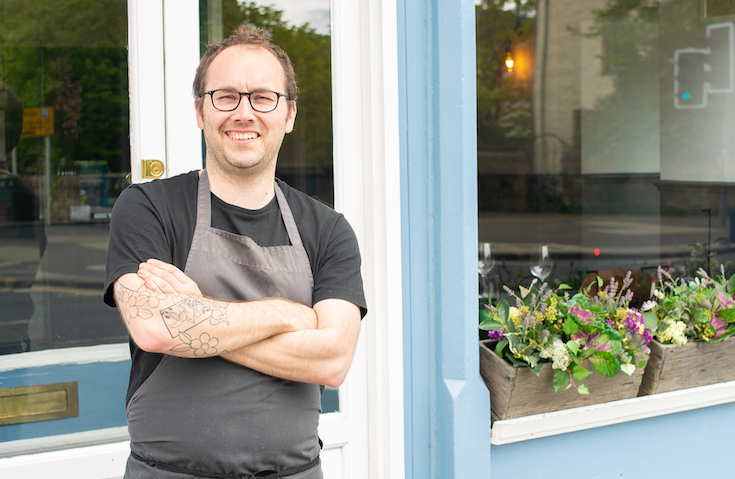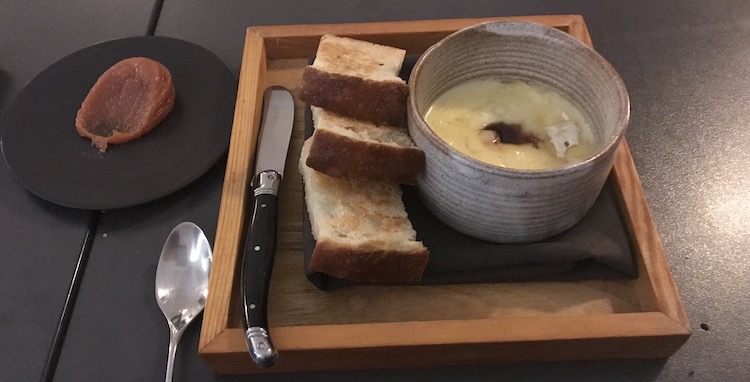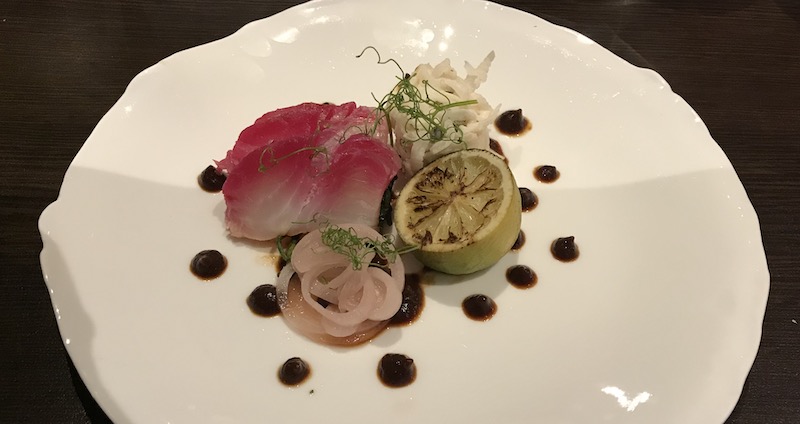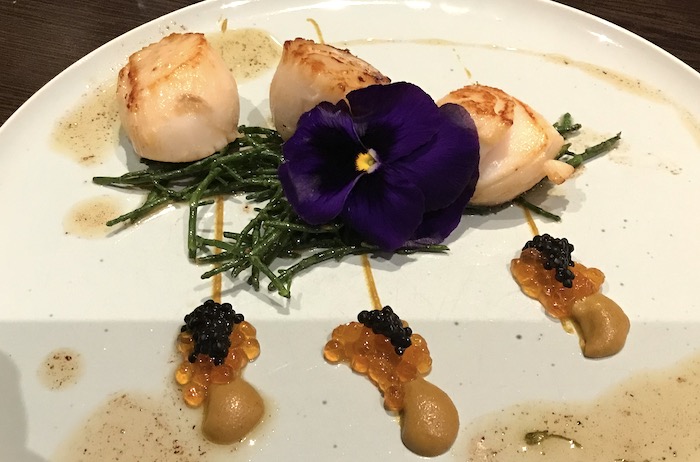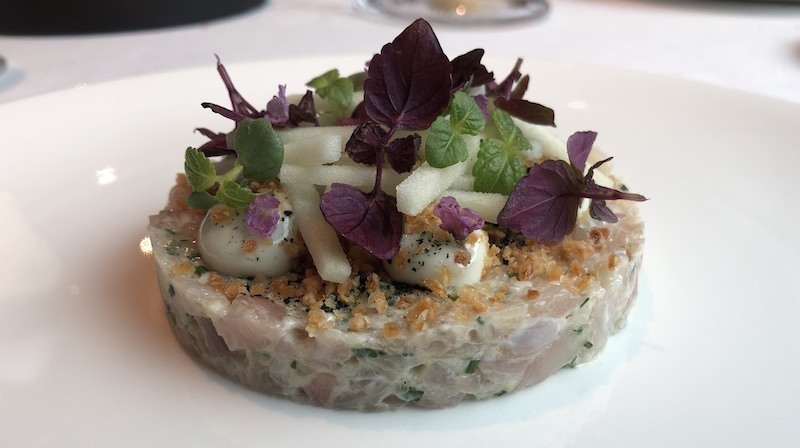
Merienda, meaning a small snack, is a 20 cover restaurant serving small plates of Mediterranean inspired food which opened in 2018. This year it was awarded a Bib Gourmand by Michelin, acknowledging its value for money. Located in Stockbridge, a fashionable area of Edinburgh already crowded with a range of eateries, it entered a highly competitive market but has held its own after receiving plaudits in the Edinburgh and Scottish press.
The restaurant is the creation of chef/owner Campbell Mickel, who already had a thriving high end corporate catering firm. After major heart surgery, from which he was given a 3% chance of survival, he remained a live wire – forgive the pun – seeing the cathartic experience as the trigger to open his first restaurant after 35 years of cooking.
Not that a Merienda represents a major slowing down of pace. Open for lunch and dinner five days a week, and with a monthly changing menu of up to 30 dishes, the pressure on cooking, coupled with the need to be creative, is ever present. With the aim of showcasing the finest Scottish produce, their availability dictates the menu composition.
High quality ingredients, including cheese, charcuterie, smoked products, poultry and meats are sourced from small artisan producers around Scotland and the Islands. Similarly, wine comes from small producers around the Mediterranean, selected to match the changing menus. Scottish craft beers, high end Scottish spirits and Scottish soft drinks complete the drinks offering.

Housed in what was once a farmhouse dating back to 1650, the bright, tall ceilinged room contains the dining area, bar and semi open kitchen. Designed by the owner, the décor has a panelled “soft” effect on one side, and an “industrial, hard” brick like effect on the bar and kitchen side. Tables and chairs in white are well spaced
Teaming up with Robbie Probert, formerly of the Michelin starred 21212, the influence of which is seen in the presentation of some of the dishes, Campbell has created an attractive formula in which guests can create their own tasting menu.

[Chef Robbie Probert and Chef/Owner Campbell Mickel]
For a small kitchen with two chefs, the number of dishes on the monthly changing menu is impressive: the November menu is divided into seven “Staples” (£3 to £9.50); five “Fields and Gardens” (£4 to £7.50); five “Rivers and Seas” (£8.20 to £8.50); five
“Farms and Pastures” (£7.90 to £8.50); and three “Sweetness” (all at £7)

[Merienda Sample Menu]
Given the quality of the ingredients, and the skill in cooking, prices are realistic. They compare favourably with other small plate restaurants, as The Bib Gourmand confirms. Whilst the dishes on the Staples section are large enough to share, it is advisable to order one’s own meat and fish courses as they tend to be smaller and likely to cause food envy if not shared.
Staples priced from £3 to £9.50 varied in flavour and texture, some being more successful than others.
Patatas Bravas (£5.90), satisfied the most: freshly cooked with a crisp, spiced crust and soft fluffy centre, a generous bowlful was served with a strong garlicy aioli. Pickled Lombardi peppers, served with herbs of Provence olives, (£3), were crisp with a more rounded, sweet flavour that offset their natural fiery heat. Padron peppers (£6.50) roasted in olive oil with smoked sea salt were suitably charred with good flavour. Serrano ham was rich and salty, being well matched with slices of nutty, mild lightly sweet Manchego cheese. (£7).
Other staples had strengths and weaknesses. Focaccia (£3) had an airy texture and good salt crust but the advertised rosemary flavour was rather muted. An olive oil dip would also have helped. Hummus blended with Bull’s blood beetroot (£6.50) had vibrant colour but was requiring an acidic lift. The accompanying toasted Pitta bread was crisp but lacked garlic flavour. These are relatively minor hiccups which need little to rectify.
Much better were the fish and meat courses, showing imagination, creativity and accuracy in cooking. Both fish dishes employed well sourced Mediterranean produce but reflected Japanese influence in presentation.

Roast Octopus, (£8.50) featured small, meaty slices of perfectly cooked tentacle – soft, delicate and well flavoured. It worked well with a rich, nutty and slightly sweet pistachio puree, fragrant basil oil and micro herbs. Finished with dots of red cabbage puree, this was a well-conceived and visually stunning dish.

Equally accomplished was a dish of Tuna carpaccio (£8.50). The ultra-thin, almost transparent, slices of stunningly fresh raw fish melted in the mouth. Grated radish gave a contrasting texture which complemented the delicate fish. Blue Spirulina, a non-fishy tasting algae, added a blaze of colour if not flavour. Lobster vinaigrette provided the necessary acidity to this attractively plated course.

Game, so easily overcooked to become tough and dry, was cooked well here. A breast of pheasant (£8.50) was accurately timed to retain its moistness and soft texture. Puy lentils cooked al dente added a peppery note which complemented the gentle gaminess of the pheasant. A deeply flavoured Grand Veneur sauce brought the elements together well.

Better still was the pork belly dish (£7.90). Slow cooked and glazed with honey and garlic, resulting in meat that was meltingly soft and full of flavour, this was a porcine treat. Apple chutney gave a spicy, sweet and sour note, working well with the rich, succulent pork. Despite the monthly changing menu, this is likely to be a popular dish that would be difficult to take off.
To finish, Panna Cotta (£7) proved a light, refreshing dessert. Set to a gentle wobble, it was dressed with mango gel which added a fruity note, organic cocoa nibs and toasted flaked almonds which gave contrasting texture and flavour. Visually, this was yet another beautifully presented dish.
Unlike other small plate restaurants, service at Merienda is not hurried. Bookings are staggered to encourage a leisurely enjoyment of food and wine. It also allows the staff to get t give more individual attention in a welcoming, informal and relaxed manner. Fine Dining Guide enjoyed chatting with owner Campbell over lunch, wishes it the continued success it deserves, and will follow its progress with interest.















